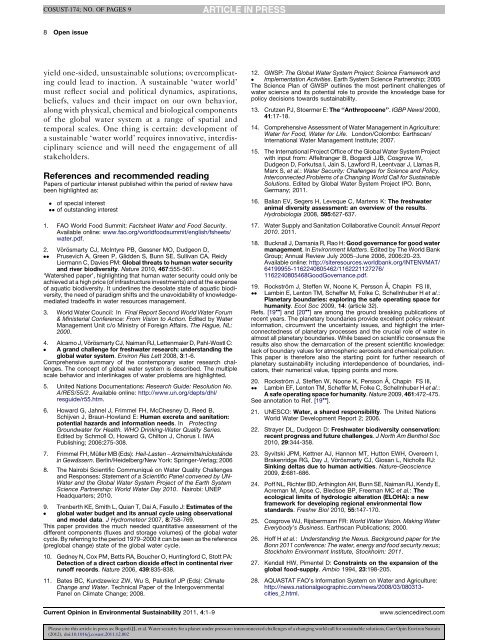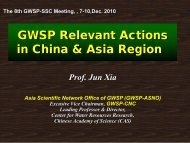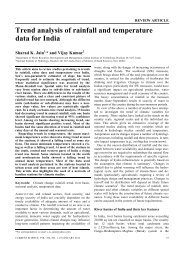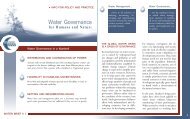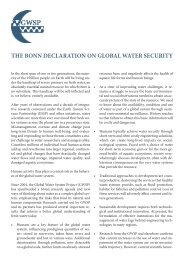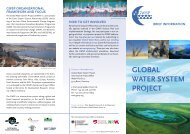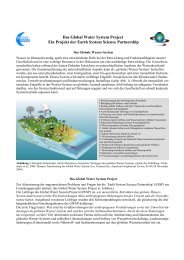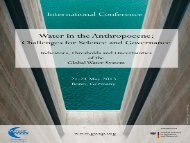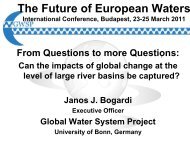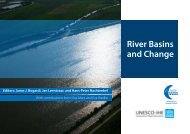Water security for a planet under pressure: interconnected ... - GWSP
Water security for a planet under pressure: interconnected ... - GWSP
Water security for a planet under pressure: interconnected ... - GWSP
You also want an ePaper? Increase the reach of your titles
YUMPU automatically turns print PDFs into web optimized ePapers that Google loves.
COSUST-174; NO. OF PAGES 9<br />
8 Open issue<br />
yield one-sided, unsustainable solutions; overcomplicating<br />
could lead to inaction. A sustainable ‘water world’<br />
must reflect social and political dynamics, aspirations,<br />
beliefs, values and their impact on our own behavior,<br />
along with physical, chemical and biological components<br />
of the global water system at a range of spatial and<br />
temporal scales. One thing is certain: development of<br />
a sustainable ‘water world’ requires innovative, interdisciplinary<br />
science and will need the engagement of all<br />
stakeholders.<br />
References and recommended reading<br />
Papers of particular interest published within the period of review have<br />
been highlighted as:<br />
of special interest<br />
of outstanding interest<br />
1. FAO World Food Summit: Factsheet <strong>Water</strong> and Food Security.<br />
Available online: www.fao.org/worldfoodsummit/english/fsheets/<br />
water.pdf.<br />
2.<br />
<br />
Vörösmarty CJ, McIntyre PB, Gessner MO, Dudgeon D,<br />
Prusevich A, Green P, Glidden S, Bunn SE, Sullivan CA, Reidy<br />
Liermann C, Davies PM: Global threats to human water <strong>security</strong><br />
and river biodiversity. Nature 2010, 467:555-561.<br />
‘<strong>Water</strong>shed paper’, highlighting that human water <strong>security</strong> could only be<br />
achieved at a high price (of infrastructure investments) and at the expense<br />
of aquatic biodiversity. It <strong>under</strong>lines the desolate state of aquatic biodiversity,<br />
the need of paradigm shifts and the unavoidability of knowledgemediated<br />
tradeoffs in water resources management.<br />
3. World <strong>Water</strong> Council: In Final Report Second World <strong>Water</strong> Forum<br />
& Ministerial Conference: From Vision to Action. Edited by <strong>Water</strong><br />
Management Unit c/o Ministry of Foreign Affairs. The Hague, NL:<br />
2000.<br />
4.<br />
<br />
Alcamo J, Vörösmarty CJ, Naiman RJ, Lettenmaier D, Pahl-Wostl C:<br />
A grand challenge <strong>for</strong> freshwater research: <strong>under</strong>standing the<br />
global water system. Environ Res Lett 2008, 3:1-6.<br />
Comprehensive summary of the contemporary water research challenges.<br />
The concept of global water system is described. The multiple<br />
scale behavior and interlinkages of water problems are highlighted.<br />
5. United Nations Documentations: Research Guide: Resolution No.<br />
A/RES/55/2. Available online: http://www.un.org/depts/dhl/<br />
resguide/r55.htm.<br />
6. Howard G, Jahnel J, Frimmel FH, McChesney D, Reed B,<br />
Schijven J, Braun-Howland E: Human excreta and sanitation:<br />
potential hazards and in<strong>for</strong>mation needs. In Protecting<br />
Groundwater <strong>for</strong> Health. WHO Drinking-<strong>Water</strong> Quality Series.<br />
Edited by Schmoll O, Howard G, Chilton J, Chorus I. IWA<br />
Publishing; 2006:275-308.<br />
7. Frimmel FH, Müller MB (Eds): Heil-Lasten – Arzneimittelru¨cksta¨nde<br />
in . Gewa¨ssern. Berlin/Heidelberg/New York: Springer-Verlag; 2006<br />
8. The Nairobi Scientific Communiqué on <strong>Water</strong> Quality Challenges<br />
and Responses: Statement of a Scientific Panel convened by UN-<br />
<strong>Water</strong> and the Global <strong>Water</strong> System Project of the Earth System<br />
Science Partnership: World <strong>Water</strong> Day 2010. Nairobi: UNEP<br />
Headquarters; 2010.<br />
9.<br />
<br />
Trenberth KE, Smith L, Quian T, Dai A, Fasullo J: Estimates of the<br />
global water budget and its annual cycle using observational<br />
and model data. J Hydrometeor 2007, 8:758-769.<br />
This paper provides the much needed quantitative assessment of the<br />
different components (fluxes and storage volumes) of the global water<br />
cycle. By referring to the period 1979–2000 it can be seen as the reference<br />
(preglobal change) state of the global water cycle.<br />
10. Gedney N, Cox PM, Betts RA, Boucher O, Hunting<strong>for</strong>d C, Stott PA:<br />
Detection of a direct carbon dioxide effect in continental river<br />
runoff records. Nature 2006, 439:835-838.<br />
11. Bates BC, Kundzewicz ZW, Wu S, Palutikof JP (Eds): Climate<br />
Change and <strong>Water</strong>. Technical Paper of the Intergovernmental<br />
Panel on Climate Change; 2008.<br />
12. <strong>GWSP</strong>: The Global <strong>Water</strong> System Project: Science Framework and<br />
Implementation Activities. Earth System Science Partnership; 2005.<br />
The Science Plan of <strong>GWSP</strong> outlines the most pertinent challenges of<br />
water science and its potential role to provide the knowledge base <strong>for</strong><br />
policy decisions towards sustainability.<br />
13. Crutzen PJ, Stoermer E: The ‘‘Anthropocene’’. IGBP Newsl 2000,<br />
41:17-18.<br />
14. Comprehensive Assessment of <strong>Water</strong> Management in Agriculture:<br />
<strong>Water</strong> <strong>for</strong> Food, <strong>Water</strong> <strong>for</strong> Life. London/Colombo: Earthscan/<br />
International <strong>Water</strong> Management Institute; 2007.<br />
15. The International Project Office of the Global <strong>Water</strong> System Project<br />
with input from: Affeltranger B, Bogardi JJB, Cosgrove W,<br />
Dudgeon D, Forkutsa I, Jain S, Law<strong>for</strong>d R, Leentvaar J, Llamas R,<br />
Marx S, et al.: <strong>Water</strong> Security: Challenges <strong>for</strong> Science and Policy.<br />
Interconnected Problems of a Changing World Call <strong>for</strong> Sustainable<br />
Solutions. Edited by Global <strong>Water</strong> System Project IPO. Bonn,<br />
Germany; 2011.<br />
16. Balian EV, Segers H, Leveque C, Martens K: The freshwater<br />
animal diversity assessment: an overview of the results.<br />
Hydrobiologia 2008, 595:627-637.<br />
17. <strong>Water</strong> Supply and Sanitation Collaborative Council: Annual Report<br />
2010. 2011.<br />
18. Bucknall J, Damania R, Rao H: Good governance <strong>for</strong> good water<br />
management. In Environment Matters. Edited by The World Bank<br />
Group; Annual Review July 2005–June 2006, 2006:20–23.<br />
Available online: http://siteresources.worldbank.org/INTENVMAT/<br />
64199955-1162240805462/1162221127276/<br />
1162240805468GoodGovernance.pdf.<br />
19.<br />
<br />
Rockström J, Steffen W, Noone K, Persson Å, Chapin FS III,<br />
Lambin E, Lenton TM, Scheffer M, Folke C, Schellnhuber H et al.:<br />
Planetary boundaries: exploring the safe operating space <strong>for</strong><br />
humanity. Ecol Soc 2009, 14: (article 32).<br />
Refs. [19 ] and [20 ] are among the ground breaking publications of<br />
recent years. The <strong>planet</strong>ary boundaries provide excellent policy relevant<br />
in<strong>for</strong>mation, circumvent the uncertainty issues, and highlight the <strong>interconnected</strong>ness<br />
of <strong>planet</strong>ary processes and the crucial role of water in<br />
almost all <strong>planet</strong>ary boundaries. While based on scientific consensus the<br />
results also show the demarcation of the present scientific knowledge:<br />
lack of boundary values <strong>for</strong> atmospheric aerosols and chemical pollution.<br />
This paper is there<strong>for</strong>e also the starting point <strong>for</strong> further research of<br />
<strong>planet</strong>ary sustainability including interdependence of boundaries, indicators,<br />
their numerical value, tipping points and more.<br />
20. Rockström J, Steffen W, Noone K, Persson Å, Chapin FS III,<br />
Lambin EF, Lenton TM, Scheffer M, Folke C, Schellnhuber H et al.:<br />
A safe operating space <strong>for</strong> humanity. Nature 2009, 461:472-475.<br />
See annotation to Ref. [19 ].<br />
21. UNESCO: <strong>Water</strong>, a shared responsibility. The United Nations<br />
World <strong>Water</strong> Development Report 2; 2006.<br />
22. Strayer DL, Dudgeon D: Freshwater biodiversity conservation:<br />
recent progress and future challenges. J North Am Benthol Soc<br />
2010, 29:344-358.<br />
23. Syvitski JPM, Kettner AJ, Hannon MT, Hutton EWH, Overeem I,<br />
Brakenridge RG, Day J, Vörösmarty CJ, Giosan L, Nicholls RJ:<br />
Sinking deltas due to human activities. Nature-Geoscience<br />
2009, 2:681-686.<br />
24. Poff NL, Richter BD, Arthington AH, Bunn SE, Naiman RJ, Kendy E,<br />
Acreman M, Apse C, Bledsoe BP, Freeman MC et al.: The<br />
ecological limits of hydrologic alteration (ELOHA): a new<br />
framework <strong>for</strong> developing regional environmental flow<br />
standards. Freshw Biol 2010, 55:147-170.<br />
25. Cosgrove WJ, Rijsbermann FR: World <strong>Water</strong> Vision. Making <strong>Water</strong><br />
Everybody’s Business. Earthscan Publications; 2000.<br />
26. Hoff H et al.: Understanding the Nexus. Background paper <strong>for</strong> the<br />
Bonn 2011 conference: The water, energy and food <strong>security</strong> nexus;<br />
Stockholm Environment Institute, Stockholm: 2011.<br />
27. Kendall HW, Pimentel D: Constraints on the expansion of the<br />
global food-supply. Ambio 1994, 23:198-205.<br />
28. AQUASTAT FAO’s In<strong>for</strong>mation System on <strong>Water</strong> and Agriculture:<br />
http://news.nationalgeographic.com/news/2008/03/080313-<br />
cities_2.html.<br />
Current Opinion in Environmental Sustainability 2011, 4:1–9 www.sciencedirect.com<br />
Please cite this article in press as: Bogardi JJ, et al. <strong>Water</strong> <strong>security</strong> <strong>for</strong> a <strong>planet</strong> <strong>under</strong> <strong>pressure</strong>: <strong>interconnected</strong> challenges of a changing world call <strong>for</strong> sustainable solutions, Curr Opin Environ Sustain<br />
(2012), doi:10.1016/j.cosust.2011.12.002


